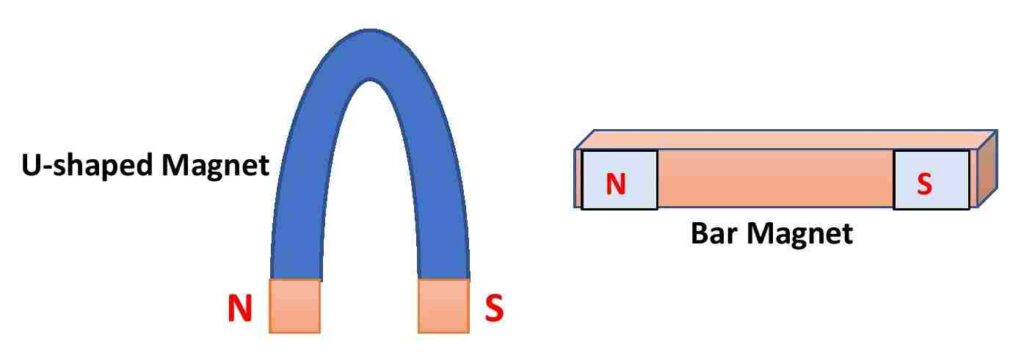The origin of magnetism is the motion of charged particles. In every atom, there are some electrons and protons. As the electrons are revolving around the nucleus and also spinning around their own axes, the atomic system behaves like a magnetic dipole. Therefore, atoms can produce a magnetic field or can have a magnetic moment inside them. Since electrons revolve around the nucleus in the same way in every substance, almost all types of substances have magnetic dipoles inside these and thereby almost all the substances can show magnetic properties. In this article, we are going to discuss different types of magnetic material and non-magnetic materials, their examples and properties.
Contents in this article:
- What is magnetic material?
- Example of magnetic material
- Properties of magnetic material
- Types of magnetic material
- Non-magnetic material
- Example of non-magnetic material
- Difference between magnetic and non-magnetic material
- Applications of magnetic material
What is magnetic material?
The materials that are affected by a magnet are known as magnetic materials. A magnet can attract or repel these types of materials and can convert those materials into magnets for a while by the process of magnetic induction.
Examples of magnetic material

Iron (Fe), Nickel (Ni), Cobalt (Co), etc. metals are magnetic materials. For more examples, check the table of magnetic materials list below. Most of these materials can become a magnet for a while by the process of magnetic induction with another magnet. But diamagnetic materials and their alloys are not considered to be magnetic materials as their magnetic interactions are very poor. Therefore, gold, silver, copper, Zinc, etc. are non-magnetic materials.
Properties of magnetic material
The properties of magnetic materials are as followings –
- An external magnetic field can induce magnetic properties inside a magnetic material.
- If a magnetic material is placed in an external magnetic field, all of its dipoles get oriented in the same direction. As a result, the net dipole moment increases and hence its magnetic property becomes stronger.
- Magnets can attract or repel all magnetic materials.
- Some of the magnetic materials can possess magnetic properties inside them even after removing the external magnetic field. This is due to the retentivity property of the material. This is not the same for all materials.
- Magnetic materials also show coercivity property. This property implies the ability to withstand the external magnetic field without becoming demagnetized.
Types of magnetic material
Depending upon the origin of magnetism and interaction with magnets, there are five types of magnetic materials or substances. These are –
- Diamagnetic material
- Paramagnetic material
- Ferromagnetic material
- Ferrimagnetic material
- Anti-ferromagnetic material
These magnetism properties have different origins and different properties. The properties and examples of all types of magnetic materials are discussed in other articles. To see those articles, click on the above blue links. Here is the list of magnetic materials.
| Diamagnetic Materials | Paramagnetic Materials | Ferromagnetic Materials | Ferrimagnetic Materials | Anti-ferromagnetic Materials |
| Zn, Cu, Pb, Ag, Au, Hg, Sb, Bi, H, H2O, NaCl | Al, K, Pt, Na, CuSO4, FeCl3, Sn, Mn | Fe, Ni, Co, Gd, CrO2 | Fe3O4, YIG | Fe2O3, MnO, MnO2, Mn2O |
Non-magnetic materials
The substances or materials that are not affected by a magnet are known as non-magnetic materials. Each atom of a nonmagnetic material has a dipole moment, but the net dipole moment of the entire substance becomes zero and these substances cannot be magnetized even after applying an external magnetic field.
Examples of non-magnetic materials list
Rubber, Plastics, Papers, feathers, mica, etc. are examples of non-magnetic materials. Some alloys also behave like non-magnetic materials. Also, diamagnetic materials like Zn, Cu, etc. and their alloys like brass are not magnetic materials as their magnetic interactions are very weak.
Difference between magnetic and non-magnetic material
| SL No | Magnetic material | Non-magnetic material |
| 1. | Affected by Magnets | Not affected by magnets |
| 2. | Can be converted into a magnet | Cannot be converted into a magnet anyway |
| 3. | The net magnetic moment may or may not be zero. | The net magnetic moment is always zero. |
| 4. | Examples: Fe, Ni, Co, Steel, etc. | Examples: Rubber, Plastic, Paper, etc. |
Application of Magnetic material
Here are some of the applications of magnetic materials –
- Magnetic materials are used in motor and generator that converts electrical energy into mechanical energy and vice-versa respectively.
- One can convert magnetic materials into permanent magnets that can be used in loudspeakers, sensors, etc.
- Magnetic materials have applications in power transformers.
- Magnetic materials have wide uses in video tape and audio tape.
Some important questions:
- Is gold a magnetic material or not? Ans: Pure gold is not a magnetic material.
- Steel is magnetic material or not? Ans: Yes
- Rubber is a magnetic material or not? Ans: No
- Is Copper magnetic material? Ans: No
- Is brass magnetic material? Ans: No
- Cobalt is magnetic material or not? Ans: Yes
This is all from the different types of magnetic materials and non-magnetic materials with their properties and examples. If you have any doubt on this topic you can ask me in the comment section below.
Thank you!
Related Posts:
- Magnetic field – Origin, definition, unit and dimension
- How to find the direction of magnetic field?
- Ferromagnetic Materials – Origin and examples
Comments are closed.